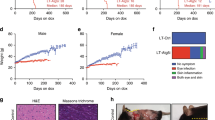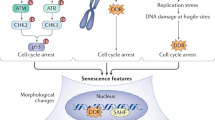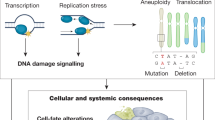Abstract
Recent studies in diverse organisms implicate proto-oncogenic pathways, including insulin-like growth factor-I (IGF-I), Ras and AKT/protein kinase B in the ageing process. Although IGF-I is thought to contribute to cancer by promoting growth and preventing apoptosis, evidence from model organisms suggests that proto-oncogene homologues might contribute to the DNA mutations and chromosomal damage that are observed in tumour cells by increasing DNA damage, in both dividing and non-dividing cells, and involving error-prone systems in DNA repair. This raises the possibility that cancer can be reduced by chronic downregulation of pro-ageing pathways.
This is a preview of subscription content, access via your institution
Access options
Subscribe to this journal
Receive 12 print issues and online access
$189.00 per year
only $15.75 per issue
Buy this article
- Purchase on Springer Link
- Instant access to full article PDF
Prices may be subject to local taxes which are calculated during checkout


Similar content being viewed by others
References
Kirkwood, T. B. Understanding the odd science of aging. Cell 120, 437–447 (2005).
Longo, V. D. & Finch, C. E. Evolutionary medicine: from dwarf model systems to healthy centenarians? Science 299, 1342–1346 (2003).
Kenyon, C. The plasticity of aging: insights from long-lived mutants. Cell 120, 449–460 (2005).
Fabrizio, P., Pozza, F., Pletcher, S. D., Gendron, C. M. & Longo, V. D. Regulation of longevity and stress resistance by Sch9 in yeast. Science 292, 288–290 (2001).
Lieber, M. R. & Karanjawala, Z. E. Ageing, repetitive genomes and DNA damage. Nature Rev. Mol. Cell Biol. 5, 69–75 (2004).
Hasty, P., Campisi, J., Hoeijmakers, J., vanSteeg, H. & Vijg, J. Aging and genome maintenance: lessons from the mouse? Science 299, 1355–1359 (2003).
Vijg, J. Aging of the Genome. (Oxford University Press, Oxford, 2007).
Rodriguez-Viciana, P. et al. Cancer targets in the Ras pathway. Cold Spring Harb. Symp. Quant. Biol. 70, 461–467 (2005).
Toker, A. & Yoeli-Lerner, M. Akt signaling and cancer: surviving but not moving on. Cancer Res. 66, 3963–3966 (2006).
Pollak, M. N., Schernhammer, E. S. & Hankinson, S. E. Insulin-like growth factors and neoplasia. Nature Rev. Cancer 4, 505–518 (2004).
Busuttil, R. A. et al. Intra-organ variation in age-related mutation accumulation in the mouse. PLoS ONE 2, e876 (2007).
Fabrizio, P. et al. Superoxide is a mediator of an altruistic aging program in Saccharomyces cerevisiae. J. Cell Biol. 166, 1055–1067 (2004).
Longo, V. D., Liou, L. L., Valentine, J. S. & Gralla, E. B. Mitochondrial superoxide decreases yeast survival in stationary phase. Arch. Biochem. Biophys. 365, 131–142 (1999).
Busuttil, R. A. et al. Organ specific increase in mutation accumulation and apoptosis rate in CuZn-superoxide dismutase-deficient mice. Cancer Res. 65, 11271–11275 (2005).
Van Remmen, H. et al. Life-long reduction in MnSOD activity results in increased DNA damage and higher incidence of cancer but does not accelerate aging. Physiol. Genomics 16, 29–37 (2003).
Futreal, P. A. et al. A census of human cancer genes. Nature Rev. Cancer 4, 177–183 (2004).
Greenblatt, M. S., Bennett, W. P., Hollstein, M. & Harris, C. C. Mutations in the p53 tumor suppressor gene: clues to cancer etiology and molecular pathogenesis. Cancer Res. 54, 4855–4878 (1994).
Imam, S. Z., Karahalil, B., Hogue, B. A., Souza-Pinto, N. C. & Bohr, V. A. Mitochondrial and nuclear DNA-repair capacity of various brain regions in mouse is altered in an age-dependent manner. Neurobiol. Aging 27, 1129–1136 (2006).
Madia, F. et al. Longevity mutation in SCH9 prevents recombination errors and premature genomic instability in a Werner/Bloom model system. J. Cell Biol. 180, 67–81 (2008).
Kovtun, I. V. et al. OGG1 initiates age-dependent CAG trinucleotide expansion in somatic cells. Nature 447, 447–452 (2007).
Issa, J. P. Aging, DNA methylation and cancer. Crit. Rev. Oncol. Hematol. 32, 31–43 (1999).
Fabrizio, P. & Longo, V. D. The chronological life span of Saccharomyces cerevisiae. Aging Cell 2, 73–81 (2003).
Madia, F., Gattazzo, C., Fabrizio, P. & Longo, V. D. A simple model system for age-dependent DNA damage and cancer. Mech. Ageing Dev. 128, 45–49 (2007).
Fabrizio, P. et al. Sir2 blocks extreme life-span extension. Cell 123, 655–667 (2005).
Chen, C., Umezu, K. & Kolodner, R. D. Chromosomal rearrangements occur in S. cerevisiae rfa 1 mutator mutants due to mutagenic lesions processed by double-strand-break repair. Mol. Cell 2, 9–22 (1998).
Fabrizio, P. et al. SOD2 functions downstream of Sch9 to extend longevity in yeast. Genetics 163, 35–46 (2003).
Hlavata, L., Aguilaniu, H., Pichova, A. & Nystrom, T. The oncogenic RAS2val19 mutation locks respiration, independently of PKA, in a mode prone to generate ROS. EMBO J. 22, 3337–3345 (2003).
Huang, M. E., Rio, A. G., Nicolas, A. & Kolodner, R. D. A genomewide screen in Saccharomyces cerevisiae for genes that suppress the accumulation of mutations. Proc. Natl Acad. Sci. USA 100, 11529–11534 (2003).
Sinclair, D. A., Mills, K. & Guarente, L. Accelerated aging and nucleolar fragmentation in yeast sgs1 mutants. Science 277, 1313–1316 (1997).
Weindruch, R. & and Walford, R. The Retardation of Aging and Disease by Dietary Restriction (Charles C. Thomas, Springfield, Illinois, 1988).
Di Micco, R. et al. Oncogene-induced senescence is a DNA damage response triggered by DNA hyper-replication. Nature 444, 638–642 (2006).
Denko, N. C., Giaccia, A. J., Stringer, J. R. & Stambrook, P. J. The human Ha-ras oncogene induces genomic instability in murine fibroblasts within one cell cycle. Proc. Natl Acad. Sci. USA 91, 5124–5128 (1994).
Pinkston, J. M., Garigan, D., Hansen, M. & Kenyon, C. Mutations that increase the life span of C. elegans inhibit tumor growth. Science 313, 971–975 (2006).
Pinkston-Gosse, J. & Kenyon, C. DAF-16/FOXO targets genes that regulate tumor growth in Caenorhabditis elegans. Nature Genet. 39, 1403–1409 (2007).
Clancy, D. J. et al. Extension of life-span by loss of CHICO, a Drosophila insulin receptor substrate protein. Science 292, 104–106 (2001).
Tatar, M. et al. A mutant Drosophila insulin receptor homolog that extends life-span and impairs neuroendocrine function. Science 292, 107–110 (2001).
LaFever, L. & Drummond-Barbosa, D. Direct control of germline stem cell division and cyst growth by neural insulin in Drosophila. Science 309, 1071–1073 (2005).
Kramer, J. M., Davidge, J. T., Lockyer, J. M. & Staveley, B. E. Expression of Drosophila FOXO regulates growth and can phenocopy starvation. BMC Dev. Biol. 3, 5 (2003).
Igaki, T., Pagliarini, R. A. & Xu, T. Loss of cell polarity drives tumor growth and invasion through JNK activation in Drosophila. Curr. Biol. 16, 1139–1146 (2006).
Brown-Borg, H. M., Borg, K. E., Meliska, C. J. & Bartke, A. Dwarf mice and the ageing process. Nature 384, 33 (1996).
Flurkey, K., Papaconstantinou, J. & Harrison, D. E. The Snell dwarf mutation Pit1dw can increase life span in mice. Mech. Ageing Dev. 123, 121–130 (2002).
Flurkey, K., Papaconstantinou, J., Miller, R. A. & Harrison, D. E. Lifespan extension and delayed immune and collagen aging in mutant mice with defects in growth hormone production. Proc. Natl Acad. Sci. USA 98, 6736–6741 (2001).
Coschigano, K. T., Clemmons, D., Bellush, L. L. & Kopchick, J. J. Assessment of growth parameters and life span of GHR/BP gene-disrupted mice. Endocrinology 141, 2608–2613 (2000).
Holzenberger, M. et al. IGF-1 receptor regulates lifespan and resistance to oxidative stress in mice. Nature 421, 182–187 (2003).
Migliaccio, E. et al. The p66shc adaptor protein controls oxidative stress response and life span in mammals. Nature 402, 309–313 (1999).
Plowman, S. J. et al. The K-Ras 4A isoform promotes apoptosis but does not affect either lifespan or spontaneous tumor incidence in aging mice. Exp. Cell Res. 312, 16–26 (2006).
Ikeno, Y., Bronson, R. T., Hubbard, G. B., Lee, S. & Bartke, A. Delayed occurrence of fatal neoplastic diseases in ames dwarf mice: correlation to extended longevity. J. Gerontol. A Biol. Sci. Med. Sci. 58, 291–296 (2003).
Vergara, M., Smith-Wheelock, M., Harper, J. M., Sigler, R. & Miller, R. A. Hormone-treated Snell dwarf mice regain fertility but remain long lived and disease resistant. J. Gerontol. A Biol. Sci. Med. Sci. 59, 1244–1250 (2004).
Salmon, A. B. et al. Fibroblast cell lines from young adult mice of long-lived mutant strains are resistant to multiple forms of stress. Am. J. Physiol. Endocrinol. Metab. 289, E23–E29 (2005).
Kennedy, M. A., Rakoczy, S. G. & Brown-Borg, H. M. Long-living Ames dwarf mouse hepatocytes readily undergo apoptosis. Exp. Gerontol. 38, 997–1008 (2003).
Dunn, S. E. et al. Dietary restriction reduces insulin-like growth factor I levels, which modulates apoptosis, cell proliferation, and tumor progression in p53-deficient mice. Cancer Res. 57, 4667–4672 (1997).
Suh, Y. et al. Aging alters the apoptotic response to genotoxic stress. Nature Med. 8, 3–4 (2002).
Chen, Z. et al. Crucial role of p53-dependent cellular senescence in suppression of Pten-deficient tumorigenesis. Nature 436, 725–730 (2005).
Levine, A. J., Feng, Z., Mak, T. W., You, H. & Jin, S. Coordination and communication between the p53 and IGF-1–AKT–TOR signal transduction pathways. Genes Dev. 20, 267–275 (2006).
Maier, B. et al. Modulation of mammalian life span by the short isoform of p53. Genes Dev. 18, 306–319 (2004).
Serrano, M., Lin, A. W., McCurrach, M. E., Beach, D. & Lowe, S. W. Oncogenic ras provokes premature cell senescence associated with accumulation of p53 and p16INK4a. Cell 88, 593–602 (1997).
Niedernhofer, L. J. et al. A new progeroid syndrome reveals that genotoxic stress suppresses the somatotroph axis. Nature 444, 1038–1043 (2006).
Wijnhoven, S. W. et al. Accelerated aging pathology in ad libitum fed XpdTTD mice is accompanied by features suggestive of caloric restriction. DNA Repair (Amst.) 4, 1314–1324 (2005).
Mostoslavsky, R. et al. Genomic instability and aging-like phenotype in the absence of mammalian SIRT6. Cell 124, 315–329 (2006).
Vijg, J. & Suh, Y. Ageing: chromatin unbound. Nature 440, 874–875 (2006).
Pluijm, S. M. et al. Unhealthy lifestyles during the life course: association with physical decline in late life. Aging Clin. Exp. Res. 19, 75–83 (2007).
Renehan, A. G. et al. Insulin-like growth factor (IGF)-I, IGF binding protein-3, and cancer risk: systematic review and meta-regression analysis. Lancet 363, 1346–1353 (2004).
Suh, Y. et al. Functionally significant insulin-like growth factor I receptor mutations in centenarians. Proc. Natl Acad. Sci. USA 105, 3438–3442 (2008).
Rudman, D. et al. Effects of human growth hormone in men over 60 years old. N. Engl. J. Med. 323, 1–6 (1990).
Laughlin, G. A., Barrett-Connor, E., Criqui, M. H. & Kritz-Silverstein, D. The prospective association of serum insulin-like growth factor I (IGF-I) and IGF-binding protein-1 levels with all cause and cardiovascular disease mortality in older adults: the Rancho Bernardo Study. J. Clin. Endocrinol. Metab. 89, 114–120 (2004).
Krzisnik C. K. Z., Battelino T., Brown M., Parks J. S. & Laron Z. The “little people” of the island of Krk — revisited. Etiology of hypopituitarism revealed. J. Endocr. Genet. 1, 9–19 (1999).
Hursting, S. D., Lavigne, J. A., Berrigan, D., Perkins, S. N. & Barrett, J. C. Calorie restriction, aging, and cancer prevention: mechanisms of action and applicability to humans. Annu. Rev. Med. 54, 131–152 (2003).
Hertweck, M., Gobel, C. & Baumeister, R. C. elegans SGK-1 is the critical component in the Akt/PKB kinase complex to control stress response and life span. Dev. Cell 6, 577–588 (2004).
Paradis, S. & Ruvkun, G. Caenorhabditis elegans Akt/PKB transduces insulin receptor-like signals from AGE-1 PI3 kinase to the DAF-16 transcription factor. Genes Dev. 12, 2488–2498 (1998).
Kaeberlein, M. et al. Regulation of yeast replicative life span by TOR and Sch9 in response to nutrients. Science 310, 1193–1196 (2005).
Lin, S. J., Defossez, P. A. & Guarente, L. Requirement of NAD and SIR2 for life-span extension by calorie restriction in Saccharomyces cerevisiae. Science 289, 2126–2128 (2000).
Longo, V. The chronological life span of Saccharomyces cerevisiae. Studies of superoxide dismutase, Ras and Bcl-2. Thesis, Univ. California Los Angeles (1997).
Ogg, S. et al. The Fork head transcription factor DAF-16 transduces insulin-like metabolic and longevity signals in C. elegans. Nature 389, 994–999 (1997).
Lin, K., Dorman, J. B., Rodan, A. & Kenyon, C. daf-16: An HNF-3/forkhead family member that can function to double the life-span of Caenorhabditis elegans. Science 278, 1319–1322 (1997).
Honda, Y. & Honda, S. The daf-2 gene network for longevity regulates oxidative stress resistance and Mn-superoxide dismutase gene expression in Caenorhabditis elegans. FASEB J. 13, 1385–1393 (1999).
Urban, J. et al. Sch9 is a major target of TORC1 in Saccharomyces cerevisiae. Mol. Cell 26, 663–674 (2007).
Longo, V. D., Gralla, E. B. & Valentine, J. S. Superoxide dismutase activity is essential for stationary phase survival in Saccharomyces cerevisiae. Mitochondrial production of toxic oxygen species in vivo. J. Biol. Chem. 271, 12275–12280 (1996).
Wei, M. et al. Life span extension by calorie restriction depends on Rim15 and transcription factors downstream of Ras/PKA, Tor, and Sch9. PLoS Genet. 4, e13 (2008).
Partridge, L. & Gems, D. Benchmarks for ageing studies. Nature 450, 165–167 (2007).
Pfeifer, GP. p53 mutational spectra and the role of methylated CpG sequences. Mutat. Res. 450, 155–166 (2000).
Acknowledgements
Related work in the laboratory of V.D.L. has been supported by an American Federation for Aging Research (AFAR) grant, by National Institutes of Health (NIH) grant AG20642 and AG025135, and by a Norris Cancer Center pilot grant. Related work has been supported by AG17242, AG20438, ES11044 and Ellison grant AG-SS-1496-05 in the laboratory of J.V. and by NIH grant CA100504 in the laboratory of M.R.L.
Author information
Authors and Affiliations
Corresponding author
Related links
Related links
DATABASES
OMIM
FURTHER INFORMATION
Rights and permissions
About this article
Cite this article
Longo, V., Lieber, M. & Vijg, J. Turning anti-ageing genes against cancer. Nat Rev Mol Cell Biol 9, 903–910 (2008). https://doi.org/10.1038/nrm2526
Issue Date:
DOI: https://doi.org/10.1038/nrm2526
This article is cited by
-
Dietary restriction: could it be considered as speed bump on tumor progression road?
Tumor Biology (2016)



